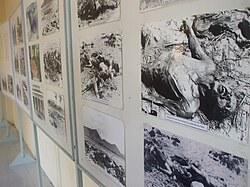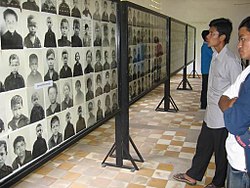Khmer Rouge



The Khmer Rouge[a] was a communist militant group in Cambodia that took over the country in 1975.[1] It was overthrown in the 1979 Vietnamese invasion of Cambodia.[1]
Overview
Under the Khmer Rouge, Cambodia became a totalitarianist state. The Khmer Rouge was responsible for the Cambodian genocide, which claimed the lives of 3,000,000 (1⁄3 of the Cambodian population at the time).[1]
History
The Khmer Rouge took over the capital city of Cambodia, Phnom Penh, on 17 April 1975. They named the country Democratic Kampuchea. Their leader was Pol Pot (formerly called Saloth Sar). Immediately, they forced everyone out of the cities and effectively turned the whole country into a giant labor camp.[1]
The Khmer Rouge were defeated by the Vietnamese in January 1979. However, the international community continued to recognize the Khmer Rouge as the government of Kampuchea for a decade after they were defeated. Therefore, the Khmer Rouge held a seat in the United Nations until 1989. In 1999, the Khmer Rouge disbanded.[1]
As per Henri Locard:[2]
The Khmer Rouge regime [was] the ultimate twentieth-century [example] of the totalitarian state. Using sheer violence and terror, a small clique [took] power. [It saw itself as] messianic [with a] mission to bring happiness and prosperity faster than any of its revolutionary model and competitors. It came to control every aspect of social and private life. No one was allowed to [hold or] express any form of opposition.
On 17 April 1975, the Khmer Rouge captured Cambodia's capital city, Phnom Penh, and took control of the country.[1][3] They renamed the country as the Democratic Kampuchea and began the Cambodian genocide.[1][3]
Beliefs
The Khmer Rouge were a "fanatical Communist movement ... which imposed a ruthless agenda of forced labor, thought control and mass execution" across Cambodia.[1][4] Most members were teenage peasant boys.[5]
The Khmer Rouge believed the people in Cambodia's cities had been poisoned and corrupted by the ideas of Western capitalism.[1][6] They wanted to return Cambodia to "Year Zero," a time when everybody in the country was a rural farmer. They thought this would create an agrarian socialist utopia - a perfect, farm-based society without social classes, where people would share everything.[1][6]
They objected to the existence of money, free markets or educated professions (e.g. medicine, engineering, law and teaching).[1] To the Khmer Rouge, being a poor farm worker was the only acceptable lifestyle. They viewed educated people as a fundamental threat to communism.[1][6]
Victims
Historians cannot say exactly how many people were killed in the Cambodian genocide. Most estimates say that between 1,400,000 and 3,000,000 Cambodian people were killed. This was between 20% and 33% of Cambodia's population back then.[1] In his 2005 article, Henri Locard wrote:[2]
Between 17 April 1975 and 7 January 1979 the death toll was about 25% of a population of some 7.8 million; 33.5% of men were massacred or died unnatural deaths [and so did] 15.7% of the women ... 41.9% of the population of Phnom Penh [was killed].
The Khmer Rouge Military and Khmer Rouge Secret Police (1975-1979)
The Revolutionary Army Of Cambodia or the Khmer Rouge Military was the official military that control Democratic Kampuchea’s Army (Revolutionary Ground Army of Cambodia) Air Force (Revolutionary Air Force of Cambodia) and the Navy (Revolutionary Navy of Cambodia) from 1975-1979 it originally was a partisan army during Cambodian Civil War from 1967-1975 . But however when the Khmer Rouge Military invaded Vietnam the Khmer Rouge Military didn’t have any good infantry troops or tanks artillery armoured trains to transport infantry or planes and helicopters or boats for paratroopers or marine infantry due to Pol Pot wanting to deindustrialise Cambodia when the Cambodian–Vietnamese War began in 1978/1979 . The Khmer Rouge also had a secret police called the Santebal which controlled Security Prison 21 from 1975-1979 .
Notelist
Khmer Rouge Media
Khmer Rouge bullet holes left at Angkor Wat temple
Photo images of the Ba Chúc massacre at a Vietnamese museum, as the massacre was one of the events that prompted the 1978 Vietnamese invasion of Kampuchea
References
- ↑ 1.00 1.01 1.02 1.03 1.04 1.05 1.06 1.07 1.08 1.09 1.10 1.11 1.12
- Hinton, Alexander Laban (1998). Why Did You Kill?: The Cambodian Genocide and the Dark Side of Face and Honor. Cambrdige University Press. Retrieved December 10, 2024.
Published online by Cambridge University Press: 26 March 2010
- Hannum, Hurst (2001). "International Law and Cambodian Genocide: The Sounds of Silence". Cambodia (1 ed.). Routledge. ISBN 9781315192918. Retrieved December 10, 2024.
- Kiernan, Ben (2012). "The Cambodian Genocide, 1975–1979". Centuries of Genocide (4 ed.). Routledge. ISBN 9780203867815. Retrieved December 10, 2024.
- Tyner, James A.; Henkin, Samuel; Sirik, Savina; Kimsroy, Sokvisal (January 1, 2014). "Phnom Penh during the Cambodian Genocide: A Case of Selective Urbicide". Sage Journals. 46 (8). doi:10.1068/a130278p. Retrieved December 10, 2024.
- Tyner, James A. (January 18, 2014). "Dead labor, landscapes, and mass graves: Administrative violence during the Cambodian genocide". Geoforum. Ohio, USA. 52: 70–77. doi:10.1016/j.geoforum.2013.12.011. Retrieved December 10, 2024.
- Hinton, Alexander Laban (1998). Why Did You Kill?: The Cambodian Genocide and the Dark Side of Face and Honor. Cambrdige University Press. Retrieved December 10, 2024.
- ↑ 2.0 2.1 Locard, Henri 2005. State violence in Democratic Kampuchea (1975-1979) and its retribution (1979-2004). European Review of History 12, 1, 121-143. The quotation includes some changes to the published summary. These changes were made to make the quotation readable in Simple English; the sense of the summary has not been changed. [1] Archived 2021-10-31 at the Wayback Machine
- ↑ 3.0 3.1 "Day One: April 17, 1975". United States Holocaust Memorial Museum. Retrieved 2024-10-23.
- ↑ "Cambodia 1975-1979". United States Holocaust Memorial Museum. April 2018. Retrieved 2024-10-23.
- ↑ "The Cambodian Genocide: Origins, Genocide, and Aftermath" (PDF). Illinois Holocaust Museum & Education Center. Retrieved 2024-10-25.
- ↑ 6.0 6.1 6.2 "Khmer Rouge Ideology". Holocaust Memorial Day Trust. Retrieved 2024-10-24.








